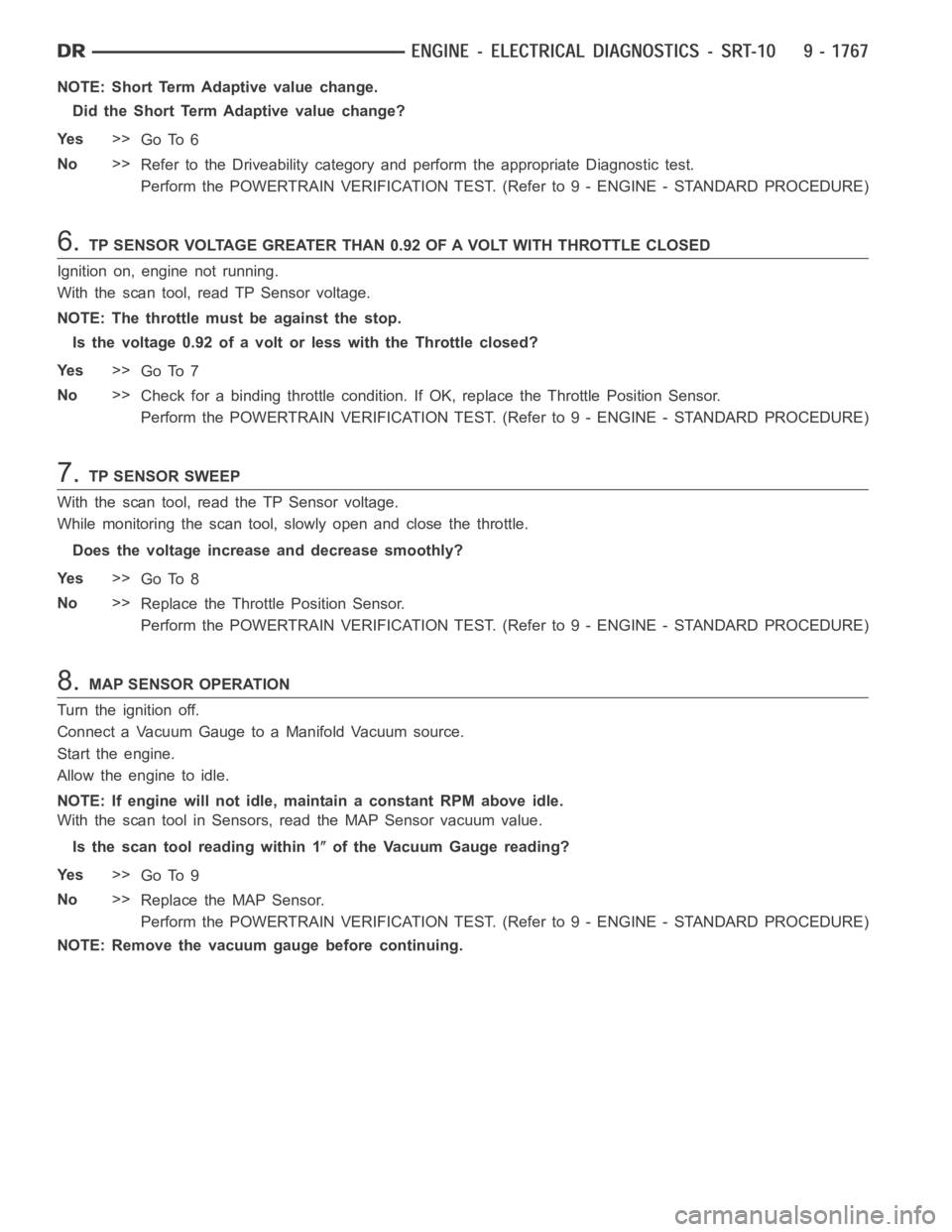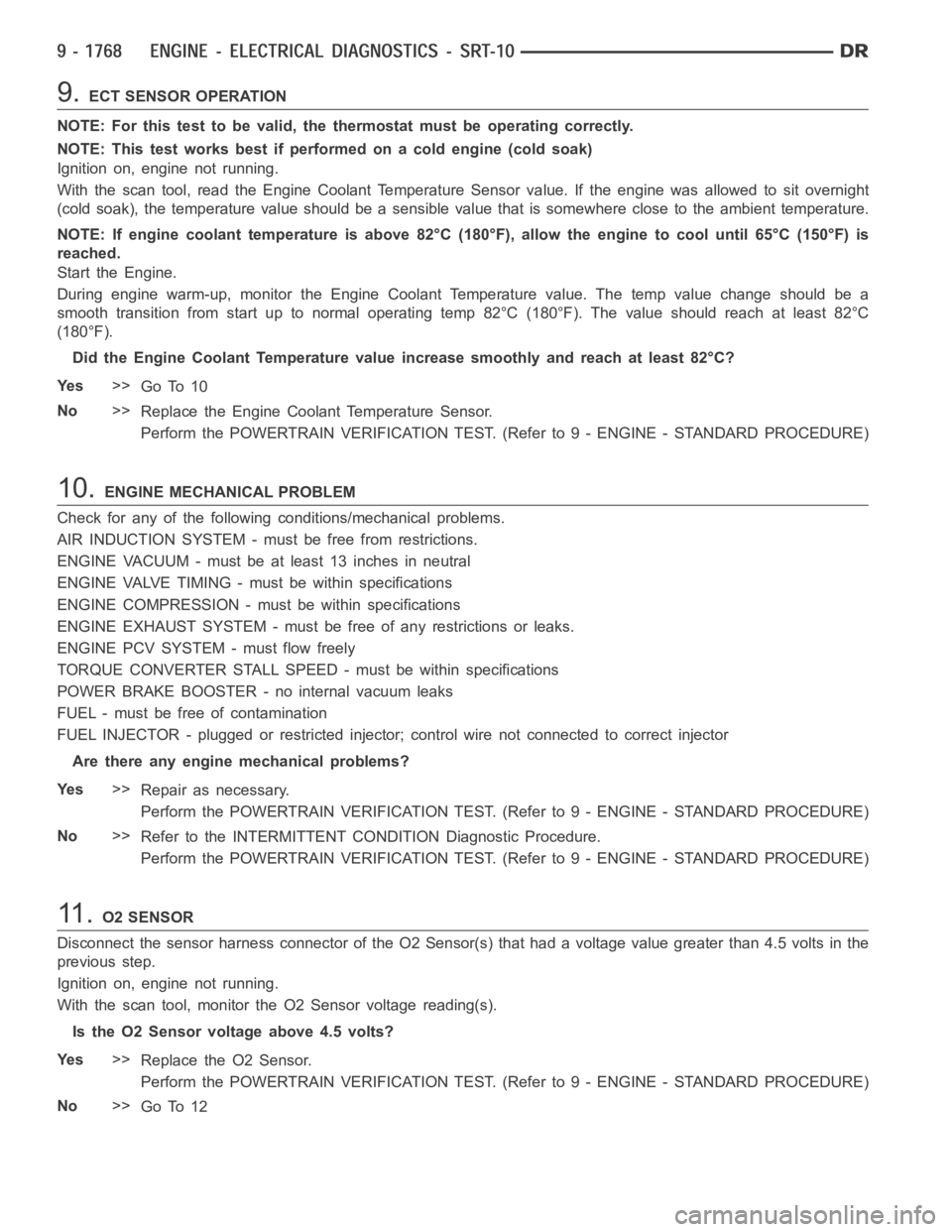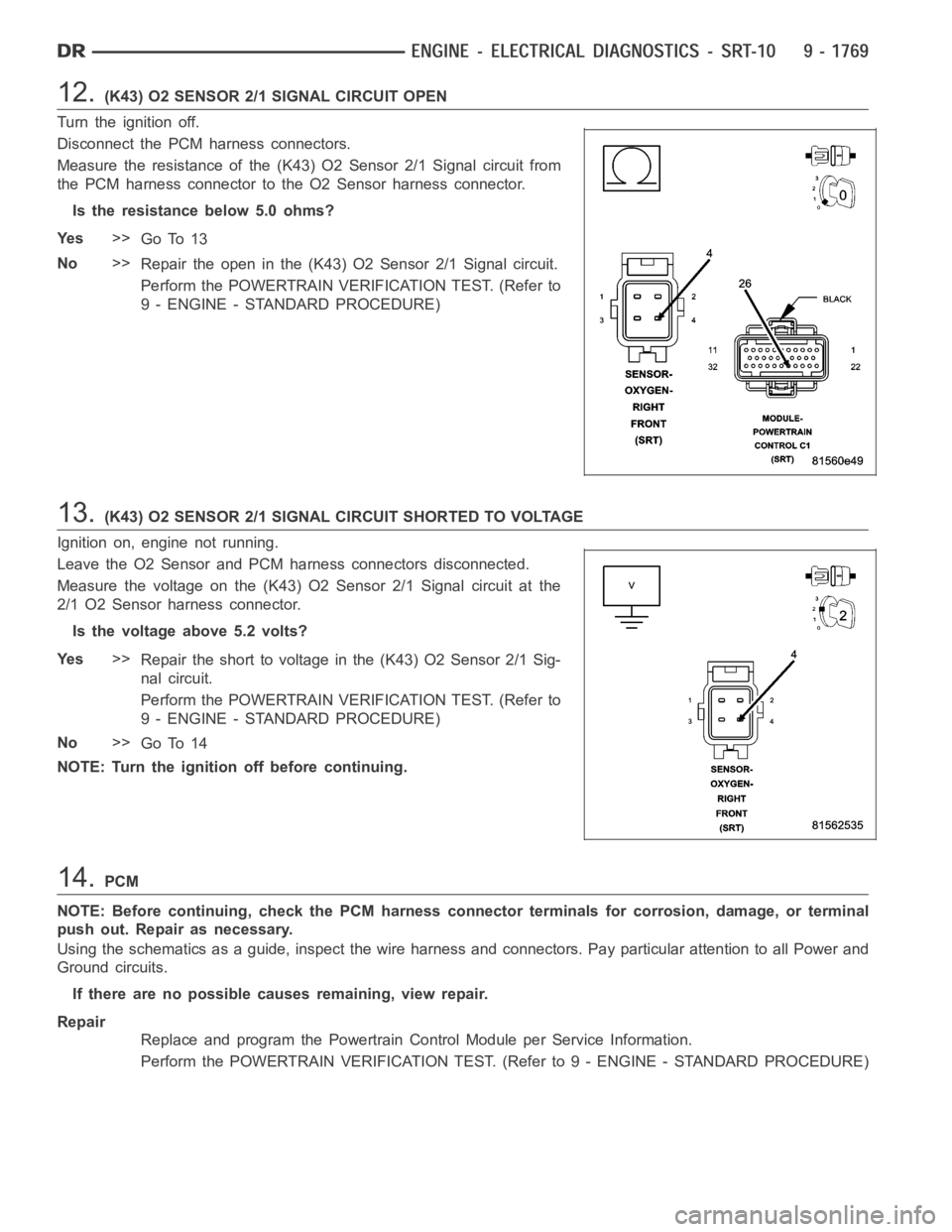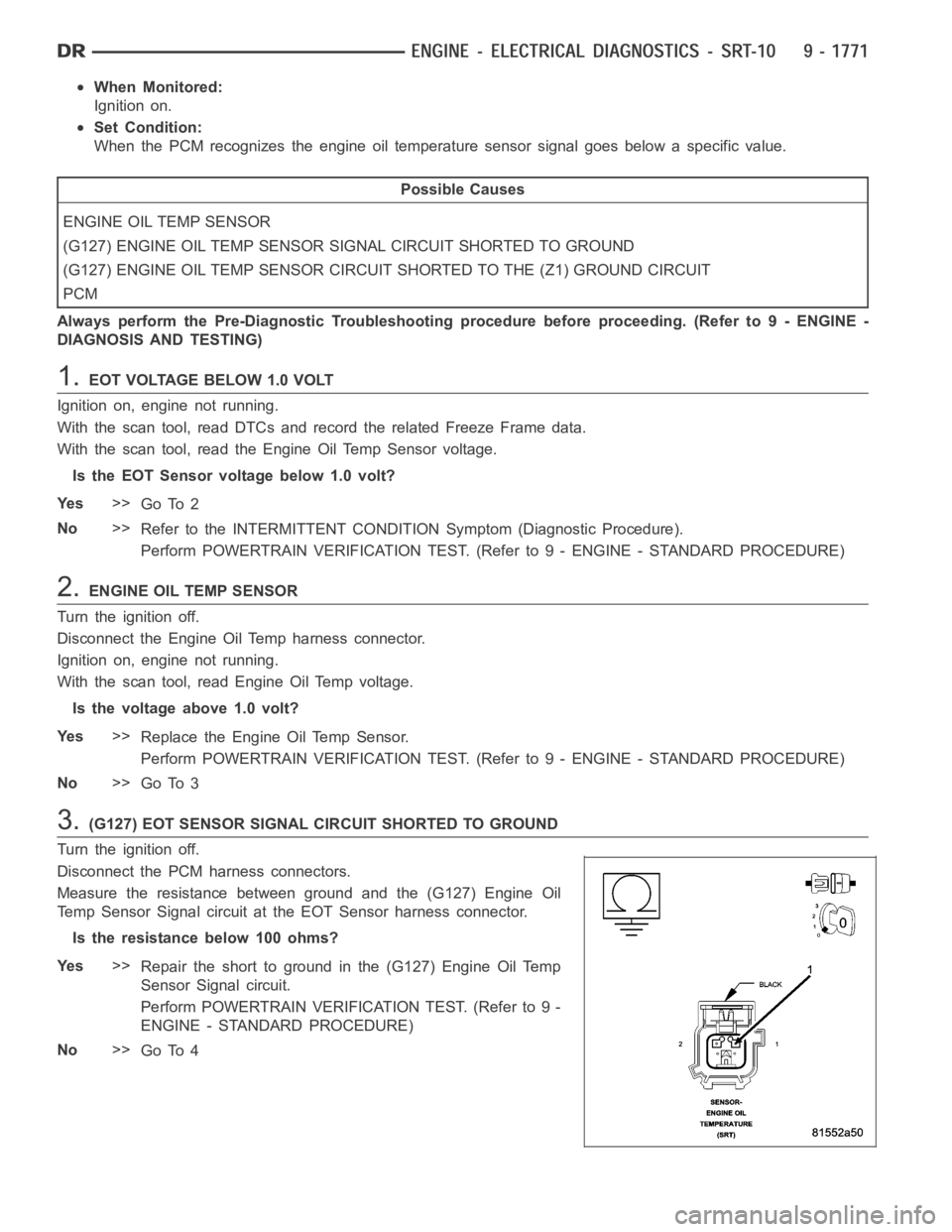Page 1076 of 5267

NOTE: Short Term Adaptive value change.
Did the Short Term Adaptive value change?
Ye s>>
Go To 6
No>>
Refer to the Driveability category and perform the appropriate Diagnostictest.
Perform the POWERTRAIN VERIFICATION TEST. (Refer to 9 - ENGINE - STANDARD PROCEDURE)
6.TP SENSOR VOLTAGE GREATER THAN 0.92 OF A VOLT WITH THROTTLE CLOSED
Ignition on, engine not running.
With the scan tool, read TP Sensor voltage.
NOTE: The throttle must be against the stop.
Isthevoltage0.92ofavoltorlesswiththeThrottleclosed?
Ye s>>
Go To 7
No>>
Check for a binding throttle condition. If OK, replace the Throttle Position Sensor.
Perform the POWERTRAIN VERIFICATION TEST. (Refer to 9 - ENGINE - STANDARD PROCEDURE)
7.TP SENSOR SWEEP
With the scan tool, read the TP Sensor voltage.
While monitoring the scan tool, slowly open and close the throttle.
Does the voltage increase and decrease smoothly?
Ye s>>
Go To 8
No>>
ReplacetheThrottlePositionSensor.
Perform the POWERTRAIN VERIFICATION TEST. (Refer to 9 - ENGINE - STANDARD PROCEDURE)
8.MAP SENSOR OPERATION
Turn the ignition off.
Connect a Vacuum Gauge to a Manifold Vacuum source.
Start the engine.
Allow the engine to idle.
NOTE: If engine will not idle, maintain a constant RPM above idle.
With the scan tool in Sensors, read the MAP Sensor vacuum value.
Is the scan tool reading within 1
of the Vacuum Gauge reading?
Ye s>>
Go To 9
No>>
Replace the MAP Sensor.
Perform the POWERTRAIN VERIFICATION TEST. (Refer to 9 - ENGINE - STANDARD PROCEDURE)
NOTE: Remove the vacuum gauge before continuing.
Page 1077 of 5267

9.ECT SENSOR OPERATION
NOTE: For this test to be valid, the thermostat must be operating correctly.
NOTE: This test works best if performed on a cold engine (cold soak)
Ignition on, engine not running.
With the scan tool, read the Engine Coolant Temperature Sensor value. If theenginewasallowedtositovernight
(cold soak), the temperature value should be a sensible value that is somewhere close to the ambient temperature.
NOTE: If engine coolant temperature is above 82°C (180°F), allow the engine to cool until 65°C (150°F) is
reached.
Start the Engine.
During engine warm-up, monitor the Engine Coolant Temperature value. Thetemp value change should be a
smooth transition from start up to normal operating temp 82°C (180°F). Thevalue should reach at least 82°C
(180°F).
Did the Engine Coolant Temperature value increase smoothly and reach at least 82°C?
Ye s>>
Go To 10
No>>
Replace the Engine Coolant Temperature Sensor.
Perform the POWERTRAIN VERIFICATION TEST. (Refer to 9 - ENGINE - STANDARD PROCEDURE)
10.ENGINE MECHANICAL PROBLEM
Check for any of the following conditions/mechanical problems.
AIR INDUCTION SYSTEM - must be free from restrictions.
ENGINE VACUUM - must be at least 13 inches in neutral
ENGINE VALVE TIMING - must be within specifications
ENGINE COMPRESSION - must be within specifications
ENGINE EXHAUST SYSTEM - must be free of any restrictions or leaks.
ENGINE PCV SYSTEM - must flow freely
TORQUE CONVERTER STALL SPEED - must be within specifications
POWER BRAKE BOOSTER - no internal vacuum leaks
FUEL - must be free of contamination
FUEL INJECTOR - plugged or restricted injector; control wire not connectedtocorrectinjector
Are there any engine mechanical problems?
Ye s>>
Repair as necessary.
Perform the POWERTRAIN VERIFICATION TEST. (Refer to 9 - ENGINE - STANDARD PROCEDURE)
No>>
Refer to the INTERMITTENT CONDITION Diagnostic Procedure.
Perform the POWERTRAIN VERIFICATION TEST. (Refer to 9 - ENGINE - STANDARD PROCEDURE)
11 .O2 SENSOR
Disconnect the sensor harness connector of the O2 Sensor(s) that had a voltage value greater than 4.5 volts in the
previous step.
Ignition on, engine not running.
With the scan tool, monitor the O2 Sensor voltage reading(s).
Is the O2 Sensor voltage above 4.5 volts?
Ye s>>
Replace the O2 Sensor.
Perform the POWERTRAIN VERIFICATION TEST. (Refer to 9 - ENGINE - STANDARD PROCEDURE)
No>>
Go To 12
Page 1078 of 5267

12.(K43) O2 SENSOR 2/1 SIGNAL CIRCUIT OPEN
Turn the ignition off.
Disconnect the PCM harness connectors.
Measure the resistance of the (K43) O2 Sensor 2/1 Signal circuit from
the PCM harness connector to the O2 Sensor harness connector.
Is the resistance below 5.0 ohms?
Ye s>>
Go To 13
No>>
Repair the open in the (K43) O2 Sensor 2/1 Signal circuit.
Perform the POWERTRAIN VERIFICATION TEST. (Refer to
9 - ENGINE - STANDARD PROCEDURE)
13.(K43) O2 SENSOR 2/1 SIGNAL CIRCUIT SHORTED TO VOLTAGE
Ignition on, engine not running.
Leave the O2 Sensor and PCM harness connectors disconnected.
Measure the voltage on the (K43) O2 Sensor 2/1 Signal circuit at the
2/1 O2 Sensor harness connector.
Is the voltage above 5.2 volts?
Ye s>>
Repair the short to voltage in the (K43) O2 Sensor 2/1 Sig-
nal circuit.
Perform the POWERTRAIN VERIFICATION TEST. (Refer to
9 - ENGINE - STANDARD PROCEDURE)
No>>
Go To 14
NOTE: Turn the ignition off before continuing.
14.PCM
NOTE: Before continuing, check the PCM harness connector terminals for corrosion, damage, or terminal
push out. Repair as necessary.
Using the schematics as a guide, inspect the wire harness and connectors. Pay particular attention to all Power and
Ground circuits.
If there are no possible causes remaining, view repair.
Repair
Replace and program the Powertrain Control Module per Service Information.
Perform the POWERTRAIN VERIFICATION TEST. (Refer to 9 - ENGINE - STANDARD PROCEDURE)
Page 1079 of 5267
P0197-ENGINE OIL TEMPERATURE SENSOR VOLTAGE TOO LOW
For a complete wiring diagramRefer to Section 8W.
Page 1080 of 5267

When Monitored:
Ignition on.
Set Condition:
When the PCM recognizes the engine oil temperature sensor signal goes below a specific value.
Possible Causes
ENGINE OIL TEMP SENSOR
(G127) ENGINE OIL TEMP SENSOR SIGNAL CIRCUIT SHORTED TO GROUND
(G127) ENGINE OIL TEMP SENSOR CIRCUIT SHORTED TO THE (Z1) GROUND CIRCUIT
PCM
Always perform the Pre-Diagnostic Troubleshooting procedure before proceeding. (Refer to 9 - ENGINE -
DIAGNOSIS AND TESTING)
1.EOT VOLTAGE BELOW 1.0 VOLT
Ignition on, engine not running.
With the scan tool, read DTCs and record the related Freeze Frame data.
With the scan tool, read the Engine Oil Temp Sensor voltage.
Is the EOT Sensor voltage below 1.0 volt?
Ye s>>
Go To 2
No>>
Refer to the INTERMITTENT CONDITIONSymptom (Diagnostic Procedure).
Perform POWERTRAIN VERIFICATION TEST. (Refer to 9 - ENGINE - STANDARD PROCEDURE)
2.ENGINE OIL TEMP SENSOR
Turn the ignition off.
Disconnect the Engine Oil Temp harness connector.
Ignition on, engine not running.
With the scan tool, read Engine Oil Temp voltage.
Is the voltage above 1.0 volt?
Ye s>>
Replace the Engine Oil Temp Sensor.
Perform POWERTRAIN VERIFICATION TEST. (Refer to 9 - ENGINE - STANDARD PROCEDURE)
No>>
Go To 3
3.(G127) EOT SENSOR SIGNAL CIRCUIT SHORTED TO GROUND
Turn the ignition off.
Disconnect the PCM harness connectors.
Measure the resistance between ground and the (G127) Engine Oil
Temp Sensor Signal circuit at the EOT Sensor harness connector.
Istheresistancebelow100ohms?
Ye s>>
Repair the short to ground in the (G127) Engine Oil Temp
Sensor Signal circuit.
Perform POWERTRAIN VERIFICATION TEST. (Refer to 9 -
ENGINE - STANDARD PROCEDURE)
No>>
Go To 4
Page 1081 of 5267
4.(G127) EOT SENSOR SIGNAL CIRCUIT SHORTED TO (Z1) GROUND CIRCUIT
Measure the resistance between the (G127) Engine Oil Temp Sensor
Signal circuit and the (Z1) ground circuit at the EOT Sensor harness
connector.
Istheresistancebelow100ohms?
Ye s>>
Repair the short between the (Z1) ground circuit and the
(G127) Engine Oil Temp Sensor Signal circuit.
Perform POWERTRAIN VERIFICATION TEST. (Refer to 9 -
ENGINE - STANDARD PROCEDURE)
No>>
Go To 5
5.PCM
NOTE: Before continuing, check the PCM harness connector terminals for corrosion, damage, or terminal
push out. Repair as necessary.
Using the schematics as a guide, inspect the wire harness and connectors. Pay particular attention to all Power and
Ground circuits.
If there are no possible causes remaining, view repair.
Repair
Replace and program the Powertrain Control Module per Service Information.
Perform POWERTRAIN VERIFICATION TEST. (Refer to 9 - ENGINE - STANDARD PROCEDURE)
Page 1082 of 5267
P0198-ENGINE OIL TEMPERATURE SENSOR VOLTAGE TOO HIGH
For a complete wiring diagramRefer to Section 8W.
Page 1083 of 5267

When Monitored:
Ignition on.
Set Condition:
When the PCM recognizes the engine oil temperature sensor signal above a specific voltage.
Possible Causes
ENGINE OIL TEMP SENSOR
(G127) ENGINE OIL TEMP SENSOR SIGNAL CIRCUIT SHORTED TO VOLTAGE
(G127) ENGINE OIL TEMP SENSOR SIGNAL CIRCUIT OPEN
(Z1) GROUND CIRCUIT OPEN
PCM
Always perform the Pre-Diagnostic Troubleshooting procedure before proceeding. (Refer to 9 - ENGINE -
DIAGNOSIS AND TESTING)
1.ENGINE OIL TEMP VOLTAGE ABOVE 4.9 VOLTS
Ignition on, engine not running.
With the scan tool, read DTCs and record the related Freeze Frame data.
With the scan tool, read Engine Oil Temp Sensor voltage.
Is the voltage above 4.9 volts?
Ye s>>
Go To 2
No>>
Refer to the INTERMITTENT CONDITIONSymptom (Diagnostic Procedure).
Perform POWERTRAIN VERIFICATION TEST. (Refer to 9 - ENGINE - STANDARD PROCEDURE)
2.ENGINE OIL TEMP SENSOR
Turn the ignition off.
Disconnect the Engine Oil Temp Sensor harness connector.
Ignition on, engine not running.
Connect a jumper wire between the (G127) Engine Oil Temp Sensor
Signal circuit and the (Z1) ground circuit in the EOT harness connector.
With the scan tool, read the Engine Oil Temp Sensor voltage.
Is the voltage below 1.0 volt?
Ye s>>
Replace the Engine Oil Temp Sensor.
Perform POWERTRAIN VERIFICATION TEST. (Refer to 9 -
ENGINE - STANDARD PROCEDURE)
No>>
Go To 3
NOTE: Remove the jumper wire before continuing.